
32 minute read
More Power
from 2021-09-TEC
Halifax EMC Solar + Storage Project Marks NC Milestone

Solar power is a growing resource for North Carolina’s electric cooperatives, although reliability of the renewable resource can be limited by, simply put, when the sun shines.
Innovations in energy storage are helping to make solar power available around the clock, and Enfieldbased Halifax Electric Membership Corporation (EMC), partnered with the North Carolina Electric Membership Corporation (NCEMC), recently marked a milestone by pairing solar power with battery storage. The 6.9-MWdc Grissom solar energy and battery storage project is the first utility scale “solar + storage” installation to be deployed by North Carolina’s electric cooperatives. At the end of 2020, there were only 73 projects of its kind in the country, according to the Energy Department’s Lawrence Berkeley National Laboratory. “This pairing of solar energy with battery storage is important,” said Jimmy Wilkins, vice president of portfolio and resource optimization for North Carolina’s Electric Cooperatives. “Solar energy is most abundant during the middle of the day, but demand peaks in the late afternoon hours in the summer and early in the morning during winter. With this project, we are capturing a renewable resource when it’s most abundant, storing it and discharging it exactly when it’s needed — there’s a lot of potential here.”
The Grissom Solar project was developed by Asheville-based Pine Gate Renewables. It will generate enough energy to power approximately 1,030 homes annually, and NCEMC is buying the power under a long-term contract. In addition to the solar energy, Grissom provides 10 MWh of additional energy storage, expected to be dispatched during peak demand hours, helping to control costs.
“With this project, we are capturing a renewable resource when it’s most “The Grissom project is an important abundant, storing it and discharging it step toward meeting sustainability goals shared by North Carolina’s electric cooperatives,” said Halifax EMC Executive Vice President and exactly when General Manager Charles Guerry. it’s needed.” “Halifax EMC is excited to share new efforts to build a brighter future for our local communities — through innovation, sustainability, and a continued focus on reliability and meeting member needs.”
Brunswick Electric’s Cypress Creek solar sites utilize Lockheed Martin batteries.
More Solar + Storage for NC Co-ops The pairing of solar panels and energy storage creates a valuable, flexible resource, which North Carolina’s electric cooperatives are taking advantage of. Since late 2017, Supply-based Brunswick Electric has been utilizing 12 solar + storage sites with a capacity of 499 kilowatts (kW) each (smaller than what’s considered “utility scale”), managed by Cypress Creek Renewables. The sites provide Brunswick Electric with a combined 6 MW of power, used during times of peak demand. NCEMC is also developing 10 solar + storage sites with a combined capacity of 18 MW, paired with 2-hour batteries. These sites are planned to come online by the end of 2022.
Renewable Energy Grows to Second-Largest Source of U.S. Power
Last year, renewable energy sources — including wind, hydropower, solar, biomass and geothermal energy — generated about 21% of all the electricity generated in the United States, or a record 834 billion kWh. This put renewable generation surpassing both nuclear (790 billion kWh) and coal (774 billion kWh) for the first time on record, according to the U.S. Energy Information Administration (EIA).
“This outcome in 2020 was due mostly to significantly less coal use in U.S. electricity generation and steadily increased use of wind and solar,” EIA said. “In 2020, U.S. electricity generation from coal in all sectors declined 20% from 2019.”
Renewables, including wind power and small-scale solar, increased by 9% during the period. Wind power, currently the most prevalent source of renewable electricity in the country, grew 14% in 2020 from 2019.
In coming years, EIA expects natural gas generation to remain dominant while other sources fluctuate. Coal is expected to rebound as the second-largest source in 2021, while renewables are expected to reclaim the #2 spot in 2022.
Annual U.S. Electricity Generation
(1990–2020)
billion kilowatthours (kWh)

Source: EIA Monthly Energy Review Note: This graph shows electricity net generation in all sectors (electric power, industrial, commercial, and residential) and includes both utility-scale and small-scale (customer-sited, less than 1 megawatt) solar.
Q: What was our main power source 100 years ago?
A: From the time our country was founded to the late 1800s, a typical family relied on wood as its primary source of energy, according to EIA. But the nation’s first commercial central power plant — Thomas Edison’s Pearl Street Station in Manhattan — used coal to create steam beginning in 1882. Several hydropower plants came online in the late 1800s, but coal technology continued to develop and overtook wood as our primary energy source by the turn of the century. “While the overall energy history of the United States is one of significant change as new forms of energy were developed, the three major fossil fuels [petroleum, natural gas and coal] have dominated the U.S. fuel mix for well over 100 years,” EIA said.

Celebrate National Drive Electric Week
National Drive Electric Week is September 25–October 3, which provides an opportunity to learn about electric vehicles (EVs) and determine if an EV is right for you. There are a few ways you can join in:
1Attend an event. Electric co-ops will be hosting events in communities around the state to introduce members to the benefits of driving electric. Find what’s happening near you from Plug-in NC, the statewide program affiliated with Raleigh-based Advanced Energy, at pluginnc.com.
2Plan an event. Nothing going on near you? Host your own event! Download a planning guide from Plug-in NC (bit.ly/plugin-event), or visit driveelectricweek.org.
3Learn more from your electric co-op. Use the opportunity to discuss EVs with your local electric co-op. Many offer incentives for driving electric, and all will be happy to discuss how an EV may make sense for you.
Moving Forward Through Farming

Agriculture is empowering Black youth at Sankofa Farms

By Pamela A. Keene Photos by Randy Berger Photography
Akemm Bell shows off Sankofa Farms peppers.
Self-described farmer, teacher and dreamer Kamal Bell lives his mission of connecting young African American boys to the land every day. But he’s about more than that. He’s an agent of change.
“There’s always been a difficult and troubled relationship between Blacks and farming; I set out to change that,” says Kamal, who was teaching at Lowe’s Grove Middle School in 2016 when he purchased 12 acres in Orange County with funding help from the U.S. Department of Agriculture. “I also saw that many of our families existed in a food desert, a place where fresh produce was expensive and hard to come by and home gardens didn’t exist.”
From that parcel of land in Cedar Grove grew Sankofa Farms LLC (sankofafarmsllc.com). As a schoolteacher, Kamal realized that connecting his Black students with the land would reap lifelong benefits in new and modern ways.
He invited several of his 7th-grade students out to visit the farm, which at that time was just rough land. Two of them — Kamoni King and Kamron Jackson — came as 12-year-olds and have since watched five acres of the farm morph into productive growing space with greenhouses and beehives.

Growing success

Building what became the farm’s Agricultural Academy took patience for Kamal. He’d invite out several students each year; one or two would stay and others would drop out. Brothers Jamil, 14, and Mikal Ali, 16, joined the academy four years ago because Jamil knew about Kamoni’s involvement. Andre Crooke, 16, and Sijaad James, 18, started the academy in March 2021.
“These students have helped with all aspects of creating the farm — from clearing the land and creating the infrastructure, to building the greenhouses, planting, tending and harvesting the crops,” he says. “They’re out here after school and on weekends, not only learning about farming, but learning leadership and life skills. They’re all on the payroll.”
Devin McAllister, Kamal’s friend from their studies together at NC A&T State University, is marketing director. Catarina Martinez, a student at Duke University, coordinates the farm’s Community Supported Agriculture program that sells fresh produce to consumers.
Additionally, Sankofa’s produce is distributed to retail locations around Orange County through Fight for $15, Duke Medical Root Causes and Table for NC.
“This way, we can help people who might not have regular access to fresh local foods at an affordable price,” Kamal says. “It’s such an accomplishment to be able to serve the community in this way and help address the food availability gap within minority groups.”
During the pandemic, the team completed the infrastructure. They planted their first produce seedlings in 2016, and they’ve been supplying locals with fresh food since October 2018.
(Left to right) student Jamil Ali, Sankofa Farms owner Kamal Bell and son Akemm, and student Mikal Ali.
Amber Bell serves as the farm’s community engagement director. “Giving people access to quality food, empowering these young people to become involved in agriculture and making a significant difference in their lives—that’s what this is all about.”


The farm recently created a lease-ahive program to introduce people to beekeeping and generate funding.

Deeper meaning
Students of the Agricultural Academy proudly refer to themselves as “Sankofites.” The farm’s name (pronounced SAHN-koh-fah) comes from a West African term meaning “to go back and get it,” symbolizing a quest for knowledge and represented by a mythical bird carrying an egg. “I translate it and understand it as ‘to remember your African ancestry as you move forward in life,’” Kamal says.
Crops include kale, tomatoes, cowpeas, peppers, radishes, watermelon, squash and okra. The farm maintains 65 beehives that this year produced 60 pounds of wildflower honey being sold through the Sankofa website.
The Bell family embraces the concept of Sankofa Farms; they live just a couple of miles away. Kamal’s wife, Amber, still teaches 4th grade and serves as the farm’s community engagement director.
“Our sons Kahlil, 7, and Akeem, 4, love to be out on the farm,” Kamal says. “Akeem loves the bees and has his own beekeeping channel on Instagram.”
As evidence of the farm’s success, Kamoni, 18, who graduated from high school this year, is headed off to North Carolina A&T State University to study agriculture. He will continue to be part of the academy, coming back on weekends. Kamron, 18, a certified beekeeper, is helping to develop the farm’s agritourism program, through “Bees in the TRAP” that stands for “Teaching Responsible Apiary Practices.” It teaches the basics of beekeeping.
Kamoni, and the other academy members, have embraced the philosophy of the farm.
“I’m going to build up the concept of the farm and pass it on to family and friends,” he says. “I will try to tell people around the world that land is wealth and wealth is power.”
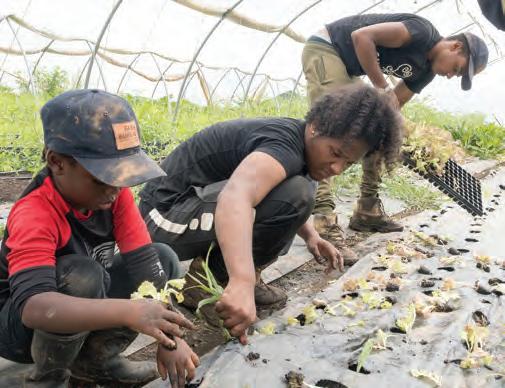
Kamal has an even bigger vision for Sankofa Farms: clearing more land and building more greenhouses where the crops are grown, and working with Amber to create a program for young Black women.
He also says he wants to open a U-pick option, and the farm recently created a lease-a-hive program as a way to introduce more people to beekeeping and generate funding. From leasing a hive on site to supporting a hive virtually, donors receive honey, regular updates about their hive and consultations about beekeeping during the season.
“The joke when I was in college was that I was going to be a poor farmer after I graduated,” says Kamal, who’s now earning his doctorate in Agricultural Extension Education at NC State. “Frankly, where I am right now feels pretty good. But what’s really the most satisfying? Knowing that we’re giving people access to quality food, empowering these young people to become involved in agriculture and making a significant difference in their lives — that’s what this is all about. It’s so much bigger than farming and Sankofa.”
Pamela A. Keene is a freelance journalist who writes for magazines and newspapers across the Southeast and nationally.
carolinacountry.com/extras Witness Kamal’s passion firsthand as he teaches young Black men how to drive their communities forward.
LIFETIME

WARRANTY
2The leading consumer reporting agency conducted a 16 month outdoor test of gutter guards in 2010 and recognized LeafFilter as the “#1 rated professionally installed gutter guard system in America.”
EXCLUSIVE LIMITED TIME OFFER
YOUR ENTIRE PURCHASE*15% OFF + 10 SENIORS & MILITARY ON TOP OF THE 15%! % OFF + 5% OFF
TO THE FIRST 50 CALLERS ONLY**
FINANCING THAT FITS YOUR BUDGET!1
www.LeafFilter.com/15off | Promo Code: 73
1Subject to credit approval. Call for details.
THE NATION’ S 2 GUTTER GUARD1 WE INSTALL YEAR-ROUND!
CALL US TODAY FOR A FREE ESTIMATE
1-844-440-9814
Manufactured in Plainwell, Michigan and processed at LMT Mercer Group in Ohio. See Representative for full warranty detail. *For those who qualify. One coupon per household. No obligation estimate valid for 1 year.**Offer valid at estimate only.
CALL FOR SUBMISSIONS
Kitchen Flops
Likely delicious, less than photogenic
Have you had a recipe come out, well, unsightly? Or maybe downright embarrassing? Make the best of it by sending us photos and stories about those baking and cooking flops that were so bad, they’re good. If you can share the recipe and an example of what it was supposed to look like, we’d appreciate that, too. We will pay $50 for each photo or story published in our December 2021 issue.
RULES
Deadline: September 30, 2021 One entry per household Digital photos should be a minimum of 1200 by 1800 pixels, prints a minimum of 4 x 6 inches. Include your name, electric co-op, mailing address and email address or phone number with your entry. Text should not exceed 200 words. If you would like us to return your photo print, include a self-addressed, stamped envelope. (We will not return others.) We retain reprint and online rights. Payment will be limited to those entries appearing in print, not entries featured solely on carolinacountry.com. SEND TO
Online: carolinacountry.com/ kitchenflops No emails, please. Mail: Carolina Country — Kitchen Flops 3400 Sumner Blvd. Raleigh, NC 27616
carolinacountry.com/extras
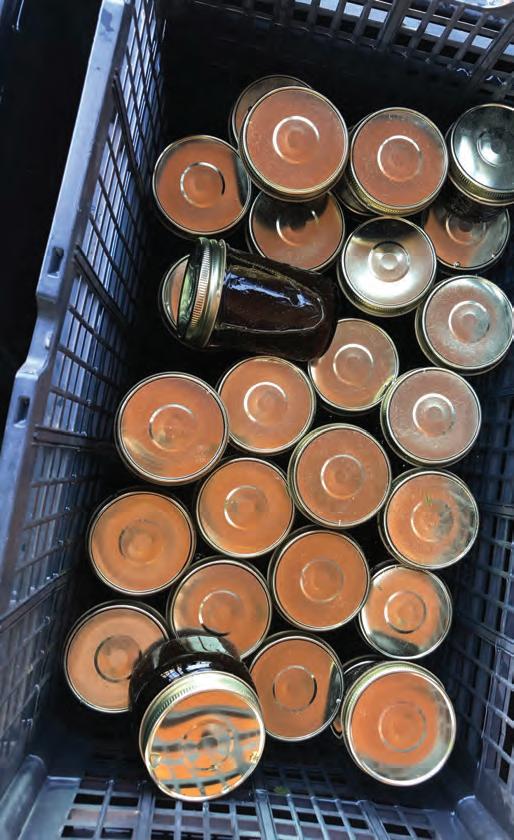
Check out the sorghum-syrup-molassesmaking process for yourself!
Mr. Doug readies loaded sorghum for processing by trimming the seed heads, which are sometimes fed to his cattle.
SWEET, SYRUPY GOODNESS
A culinary adventure following sorghum from field to biscuits
Story and photos by Wendy Perry
Before I set out on my latest culinary adventure, this time to the heights of our Blue Ridge Mountains, I needed to understand: Is what I’ve always called “molasses” truly that? Or was it just syrup some of us grew up calling molasses? One thing was (and remains) clear: I love it.
My earliest recollections of this tasty elixir was the jar, always there, on my grandma’s kitchen work table, beside a plate of soft butter and biscuits she’d made that morning. A great uncle had a “molasses cook’n” each fall when I was growing up, and Daddy would always take me there.
As a grownup, with never-ending curiosity for learning about and documenting “old-timey” food preparation methods, I road-tripped out to Western North Carolina to spend a day with one of the few NC farmers — Mr. Doug Harrell — still making sorghum syrup, or what he calls molasses syrup (and what I’ll just call the good stuff), the old way. I had a feeling I’d be putting all of my senses to work on this trip.
OUT IN THE FIELD
Meandering my way down winding back roads of Mitchell County as the sun was peeping through the trees, I was feeling a bit giddy, eager for the day ahead. When I arrived at Harrell Hill Farms on a cooking day last September, I could see the community spirit there at the molasses cookhouse, where family and friends were gathered. Mr. Doug, whose kind, gentle spirit and eagerness to share were immediately apparent on a prior phone call, moseyed over to greet me. He gave me a hug, as if we were longtime friends, this gentleman in his well-broke-in overalls, as comfortable as a second skin.
“Hop in the truck, Wendy,” he exclaimed. “Let’s go to the field!” The sun was just up, and no time to waste. Somehow, our ride — a tattered old truck — got us through a few mud pits along the path, remnants of Hurricane Laura that had skimmed through a few days prior and briefly delayed harvest.
As we came out from the wooded trail into an open field, we were met by a few of his 21 grandchildren, neighborhood youth and some 4-Hers, there to swoop up armfuls of the tall golden-green sorghum. Mr. Doug hopped on his tractor and quickly mowed down rows of stalks, which they loaded into the truck bed.
I took a deep breath of the pure, brisk mountain air, listening to the quiet crunch underfoot of the freshly mown sorghum as it was gathered.
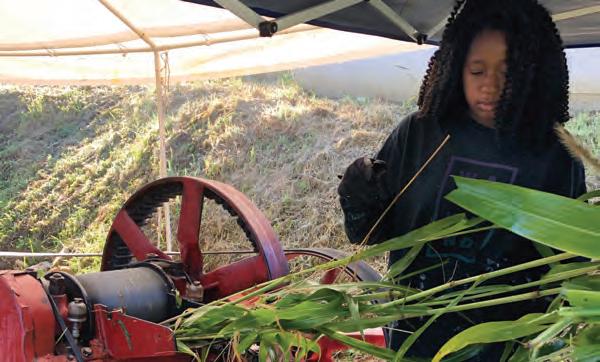

INTO THE MILL
Mr. Doug’s granddaughter, Ashlyn “Lil’ Bit” McDaniel, hopped in the truck with us, and back to the cook shed we went with the first of many loads of sorghum. For hours on end, Lil’ Bit fed stalks into the cane mill, a chug-a-lug contraption from 1903, still doing its duty today. The room filled with the raw aroma of freshcrushed juice being strained and fed into a big repurposed dairy milk vat, where it would cook for hours for the next day’s syrup. I was fascinated to see how what looked like pond scum being extracted came to be liquid deliciousness.
The boiled juice from yesterday’s harvest was slowly released into the maze-like evaporator cooking pan, watched over so carefully by Mr. Doug’s brother, Larry. He’s the expert at this, continually stirring the mixture and skimming off impurities while keeping a close eye on the temperature. As the syrup cooked down and moved through the vats to the perfect temperature (between 232 and 243 degrees), a rich smell arose. The syrup reached the end of the pan, free of impurities and ready to move to the vat for bottling.
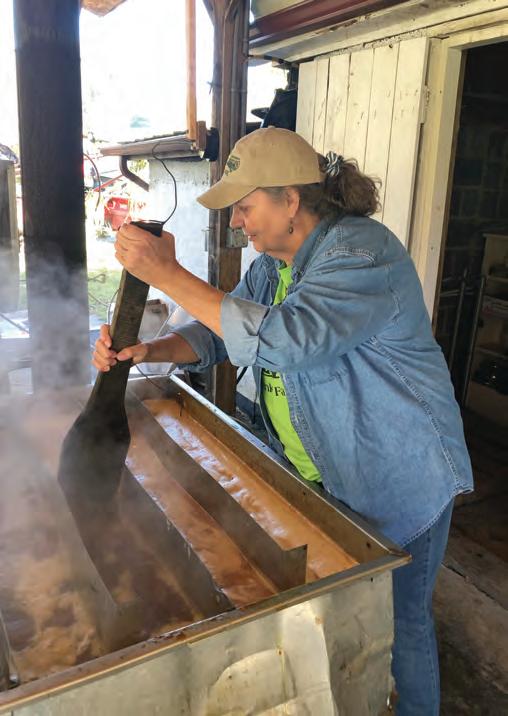
Larry carefully moves the finished hot syrup from the evaporator into the cooling and bottling tank. Using the decades-old, seasoned paddle, story author Wendy stirs the hot syrup as it reduces in the evaporator.
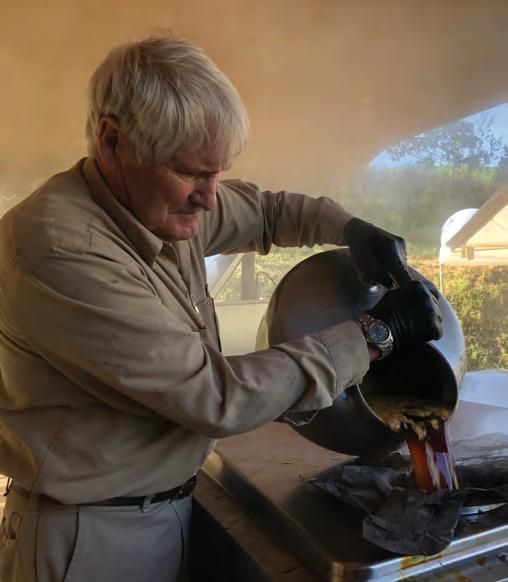
OFF TO THE TABLE
Mr. Doug’s daughter, Cyndi, turned a valve on and off, hundreds of times, meticulously bottling each and every jar of syrup. She’d then lower each into a vat of water to cool before boxing them up for local grocers, restaurants and a few family and friends.
It was there, holding my finger under that spigot for a drip, where I got my first taste of the day’s work. It was as good, no, better than any I could remember. I had seen all of the love and community spirit poured into each and every jar. And could taste it, too.
My heart was touched by Mr. Doug’s love of his trade, family and friends, and the legacy he is leaving on this community and land. Was I surprised to learn he was recently ordained as a minister? Or that a 2017 leukemia diagnosis hasn’t slowed him down? Nope. “Wendy, I just want to show folks that no matter what comes our way, we just have to keep on, and let Jesus lead the way,” Mr. Doug said.
Mr. Doug has been a steward of the farm, worked by his family since Hugh Harrell was granted the land in 1796, and his son has recently decided to move from Arizona to continue the family legacy.
I’ll admit: I’m still a tad confused about the whole syrup/ molasses thing. Technically, molasses is derived from sugar cane, and sorghum syrup comes from the sorghum like you’ll find on Harrell Hill Farms. But Mr. Doug calls his “molasses syrup,” since some of his customers call it one thing and some another. So we’ll go with that.
Now, pass me a biscuit, please.
Wendy Perry, a culinary adventurist and blogger, chats about goodness around NC on her blog at WendysHomeEconomics.com.
To buy your own
Harrell Hill Farms sells both sorghum syrup molasses as well as grass-fed beef directly from its farm. Please call or email first to check availability. Harrell Hill Farms 467 Byrd Road, Bakersville, NC 28705 828-467-0280 dougharrell68@gmail.com
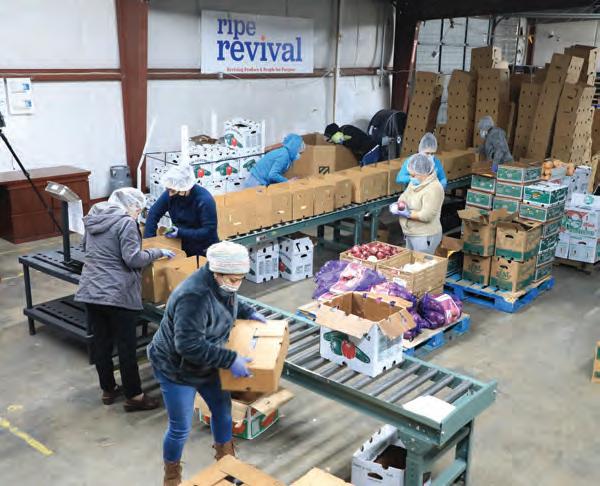
Will Kornegay Ripe Revival Market’s Rocky Mount warehouse
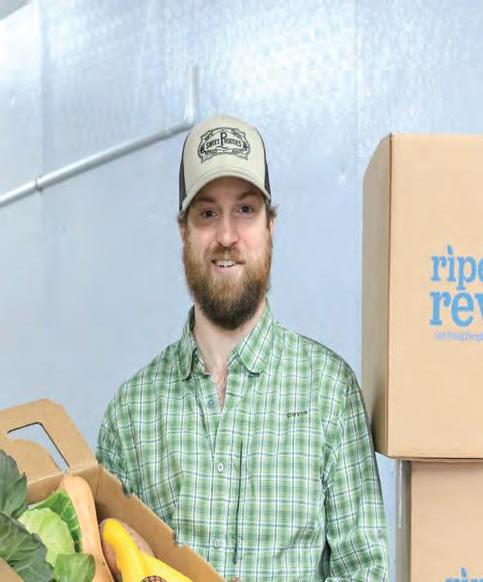
Fresh Produce, Delivered
Will Kornegay is closing the gap between food excess and access
By Bridgette A. Lacy | Photos courtesy of Ripe Revival Market
In early 2020, Will Kornegay and his sister, Laura Hearn, were gearing up to expand distribution of locally sourced gummies produced through the company they co-created, Ripe Revival. And then the Covid19 pandemic hit. Retailers were no longer accepting new vendors; but Will saw an opportunity to launch a new project.
That April, he pivoted to sell boxes of meat, dairy, fruits and vegetables — sourced from North Carolina farms in season — for delivery to consumers’ front doors.
He focused his new company, called Ripe Revival Market (riperevivalmarket.com), on three pandemic challenges: consumers who wanted to avoid grocery stores and needed groceries delivered to their homes; Eastern NC farmers and local food distributors who needed new markets for their goods as restaurants, schools and other institutional buyers scaled back their operations; and the rising number of families experiencing food insecurity.
He also created the company’s Community Supported Produce Box, where purchasers receive a box of produce for themselves and a second box is donated to a North Carolina family struggling to access healthy food options.
In an effort to reduce food waste, the community-supported boxes feature 10 to 12 pounds of good but imperfect fruits and vegetables, such as potatoes with blemishes or fruits that are misshapen.
“It helps the farmer because it’s produce they couldn’t sell at a grocery store,” Will says. “It’s perfectly edible, but grocery stores won’t buy it.”
“Forty percent of produce is lost and left in the field every year because it’s considered ugly,” he continues. “At the same time, one in seven families in the U.S. face food insecurity. I want to bridge the gap between excess and access.”
Ripe Revival Market’s delivery area includes homes in Beaufort, Craven, Cumberland, Durham, Edgecombe, Greene, Lenoir, Nash, New Hanover, Onslow, Orange, Pitt, Wake, Wayne and Wilson counties.
“We distribute free boxes to families in Nash, Edgecombe, Wilson and Halifax counties,” he says.
Liz Lord, the senior engagement director for the Harrison Family YMCA in Rocky Mount, says families have been grateful and happy to receive fresh produce.
“We serve Nash and Edgecombe counties. A lot of food pantries have canned goods but not fresh, local produce. We deliver Will’s produce boxes to families,” Liz says. “There are a number of families that face transportation issues. They don’t have a vehicle, or gas money. Getting to the food can be a real issue. It’s hard if you live in a mobile home park in the county, or neighborhoods in the city, where they have to walk a tremendous distance. They don’t have a good way to access the supermarket, grocery stores.”
Will, a Rocky Mount native, always wanted to work in agriculture.
“My family didn’t farm, but I loved that lifestyle,” he says.
After graduating from NC State University with a bachelor’s in business administration and a concentration in marketing, he moved to Snow Hill. There he worked for the “Sweet Potato Man” himself, Bobby Ham, president of Ham Farms.
“It was my first job,” Will says. “I was immersed in produce and was able to see a large-scale operation of food production, processing and produce packaging. I gained an appreciation of farming, and began to realize small farmers needed help to utilize 100 percent of the crops.”
As a result, one of Will’s missions has become educating people about ugly produce.
“Just cut that defect out of it, it’s fine to eat,” he says. “It’s okay if it has a small crack or a small hole. That is just something that happens to fresh produce. It might have veins on it. Perfectly edible. We need to change how we look at that.”
Bridgette A. Lacy (bridgettelacy.com) is a freelance writer and the author of “Sunday Dinner, a Savor the South cookbook” by UNC Press.
Bad to the Bone

Full tang stainless steel blade with natural bone handle —now ONLY $79!



The very best hunting knives possess a perfect balance of form and function. They’re carefully constructed from fine materials, but also have that little something extra to connect the owner with nature. If you’re on the hunt for a knife that combines impeccable craftsmanship with a sense of wonder, the $79 Huntsman Blade is the trophy you’re looking for. The blade is full tang, meaning it doesn’t stop at the handle but extends to the length of the grip for the ultimate in strength. The blade is made from 420 surgical steel, famed for its sharpness and its resistance to corrosion. The handle is made from genuine natural bone, and features decorative wood spacers and a hand-carved motif of two overlapping feathers— a reminder for you to respect and connect with the natural world. This fusion of substance and style can garner a high price tag out in the marketplace. In fact, we found full tang, stainless steel blades with bone handles in excess of $2,000. Well, that won’t cut it around here. We have mastered the hunt for the best deal, and in turn pass the spoils on to our customers. But we don’t stop there. While supplies last, we’ll include a pair of $99 8x21 power compact binoculars and a genuine leather sheath FREE when you purchase the Huntsman Blade.
Your satisfaction is 100% guaranteed.
Feel the knife in your hands, wear it on your hip, inspect the impeccable craftsmanship. If you don’t feel like we cut you a fair deal, send it back within 30 days for a complete refund of the item price. Limited Reserves. A deal like this won’t last long. We have only 1120 Huntsman Blades for this ad only. Don’t let this beauty slip through your fingers. Call today!
BONUS! Call today and you’ll also receive this Huntsman Blade $249* genuine leather sheath! Offer Code Price Only $79 + S&P Save $170

EXCLUSIVE FREE
Stauer® 8x21 Compact Binoculars -a $99 value-
with purchase of Huntsman Blade
What Stauer Clients Are Saying About Our Knives
êêêêê “This knife is beautiful!”
— J., La Crescent, MN êêêêê “The feel of this knife is unbelievable...this is an incredibly fine instrument.”
— H., Arvada, CO
1-800-333-2045
Your Insider Offer Code: HUK580-01
You must use the insider offer code to get our special price.
Rating of A+
Stauer ®
14101 Southcross Drive W., Ste 155, Dept. HUK580-01 Burnsville, Minnesota 55337 www.stauer.com

Not shown actual size. *Discount is only for customers who use the offer code versus the listed original Stauer.com price.
California residents please call 1-800-333-2045 regarding Proposition 65 regulations before purchasing this product.

•12” overall length; 6 ¹⁄2” stainless steel full tang blade • Genuine bone handle with brass hand guard & bolsters • Includes genuine leather sheath
Stauer… Afford the Extraordinary. ®

R eal People. Real Power.

Deadline Approaching
Teachers in K-12 classrooms have until Friday, September 10, to submit Bright Ideas Grant Applications in Tideland EMC-served counties.
The maximum grant award per project is $2,000. To learn more about the program and Tideland’s funding guidelines and to submit an online application visit ncbrightideas.com.
Marsh Retirement
Retirement season officially opened the afternoon of August 5 when senior staking technician John Marsh turned the lights off one last time at his Grantsboro office. He originally joined Tideland as a line superintendent in April 1993 after an 11-year career with the City of New Bern. John and his wife, Wendy, look forward to continued homesteading in Tideland territory. And while John hasn’t completely ruled out returning for limited storm duty, it would likely depend on hunting season.

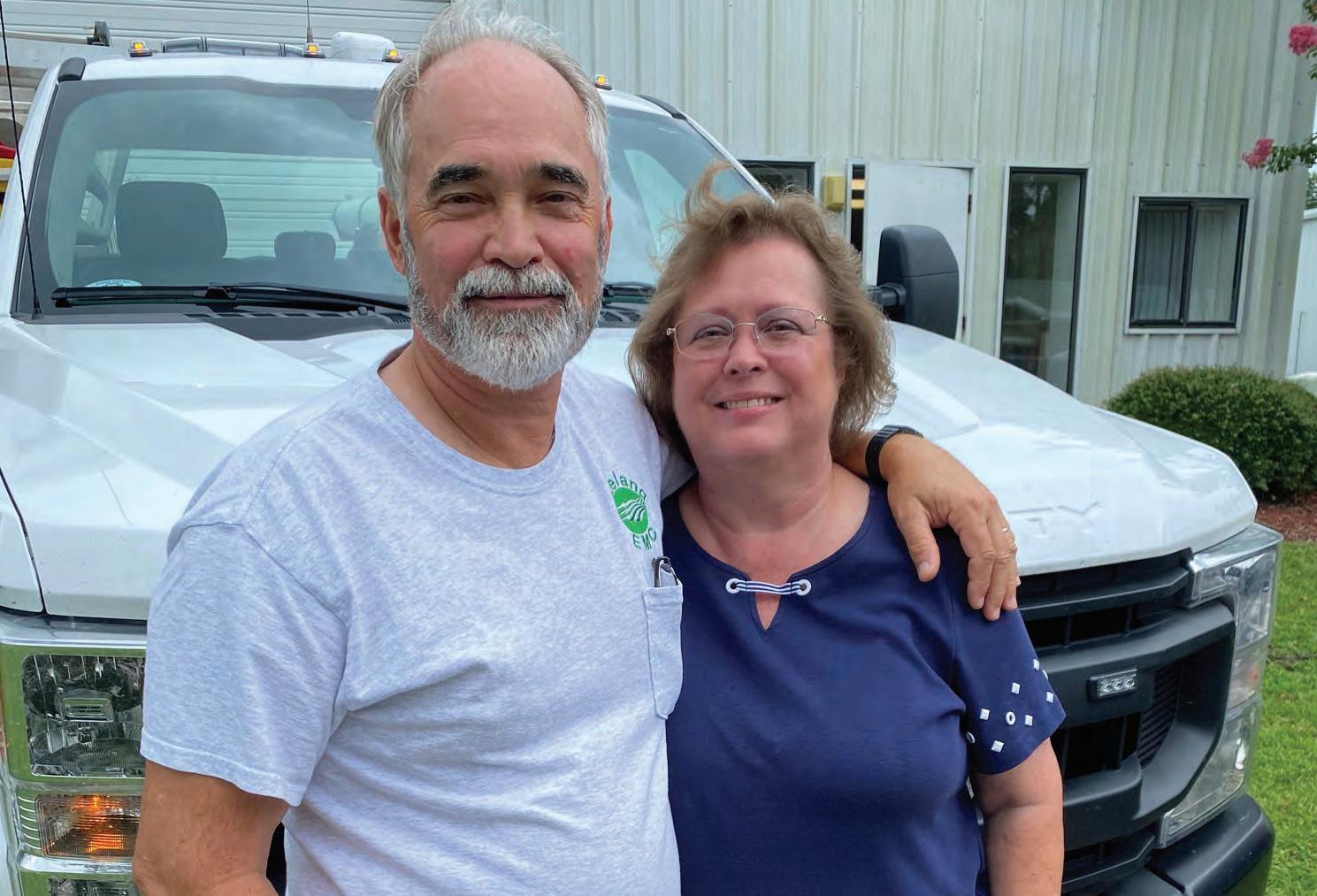

Peak preparedness
Peak hurricane season is upon us and we’re back with another reminder about the importance of emergency preparedness. That’s particularly true if you are new to eastern North Carolina and have not yet had to weather a severe tropical event.
While there are plenty of emergency preparedness checklists circulating, here are a few items we want to reiterate.
• Read your property insurance policy. Know how to start a claim and what documentation will be required. • Have the name and contact info of one or more licensed electricians handy in the event your metered service needs repairs before power can be restored. • If you evacuate, turn off as many unnecessary breakers as possible before leaving.
This helps reduce system load during power restoration efforts. • Test your backup generator now. Don’t wait until a storm is on the way. Have spare parts on hand since they will likely be in short supply once a storm arrives. Be sure you have a working carbon monoxide detector if you own a generator. It could save your life.

It’s the heat. And the humidity.
This summer our energy auditors spent a good bit of time utilizing the humidity index when reviewing energy consumption data. The index is available for member viewing on the member portal under the “Energy Usage” tab.
High humidity can lead to uncomfortable indoor conditions if the home’s air-conditioning system is oversized, which leads to short-cycling and a failure to remove adequate amounts of moisture from the home.
Increasingly, our energy auditors are finding Tideland members with dehumidifiers located in crawlspaces. For numerous reasons, we are not proponents of such units unless the crawlspace has been properly encapsulated. Minus adequate vapor barriers and proper encapsulation, dehumidifiers are fighting a loosing battle when the outdoor humidity is high. A small 30-pint dehumidifier rated at 300-watts that operates 24-hours a day consumes 7.2 kilowatt hours of
electricity. Multiplied over 30 days that would contribute 216 kWh to the monthly electric bill ($26.95). To learn more about proper crawlspace encapsulation visit crawlspaces.org.
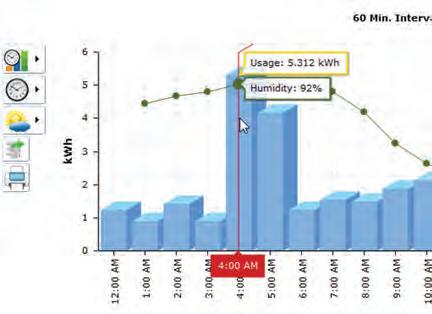
This is a
crime Yard sale. Lost pet. Fish fry. Favorite political candidate. Free roofing estimates. No matter the reason, it is illegal in North Carolina to affix signage to a utility pole. Doing so can pose a danger to utility personnel and cause premature pole failure.
2021 Annual Meeting scheduled for October 21
by PAUL SPRUILL
GENERAL MANAGER & CHIEF EXECUTIVE OFFICER
Tideland EMC’s board of directors is pleased to announce the scheduling of an in-person annual meeting. Last year’s meeting was conducted via audio conference call in observance of both federal and state health and safety recommendations related to Covid-19.
This year we will return to the Continuing Education Auditorium on the campus of Beaufort County Community College in Washington. Annual meeting attendees will be required to adhere to any of the facility’s masking and social distancing policies that may be in place at the time of the event.

Official Notice
You are hereby notified that the 2021 Annual Meeting of Members of Tideland Electric Membership Corporation will be held at Beaufort County Community College in Washington, NC, on Thursday, October 21, at 7:00 p.m. to take action upon the following matters:
1. the reports of officers, directors and committees; 2. the election of four (4) directors of the cooperative to serve threeyears terms; and 3. the transaction of such other and further business, which may come before the meeting, or any adjournment thereof.
In accordance with the Cooperative’s bylaws, the nominating committee nominated the following members as candidates for seats on the Board of Directors:
District 4: Charles Slade District 5: Paul Sasnett District 6: Wayne Sawyer District 8: Clifton Paul
There were no nominations by petition. Meeting registration will begin at 6:30 p.m.
Mark Carawan Secretary
September rights-of-way schedule
Tideland has hired Lucas Tree Experts and Gunnison Tree Service to trim trees in our rights-ofway. During September, Lucas will be trimming out the Rose Bay and Dowry Creek circuits. Gunnison will be trimming out the Hyde County circuit out of our Pantego substation.
Our rights-of-way treatment contractor, Progressive Solutions, will be spraying in our Pantego operational district.
We will have construction crews with Lee Electric on the Orchard Creek Road portion of the Merritt circuit, the Rose Bay circuit along Highway 264, and on the Allen Road are of the Dowry Creek circuit.
River City construction crews will continue pole change outs along Broad Creek Road (Washington), Braddy Road and the Pamlico Plantation circuit.
An Osmose crew will be conducting pole inspections in our Engelhard operational district.
Holiday closing
Tideland offices will be closed Monday, September 6, in observation of Labor Day.
On-call crews will be available to respond to outages and service emergencies. Our 24-hour call center will also be staffed during that time.
John Marsh and Josh Bain
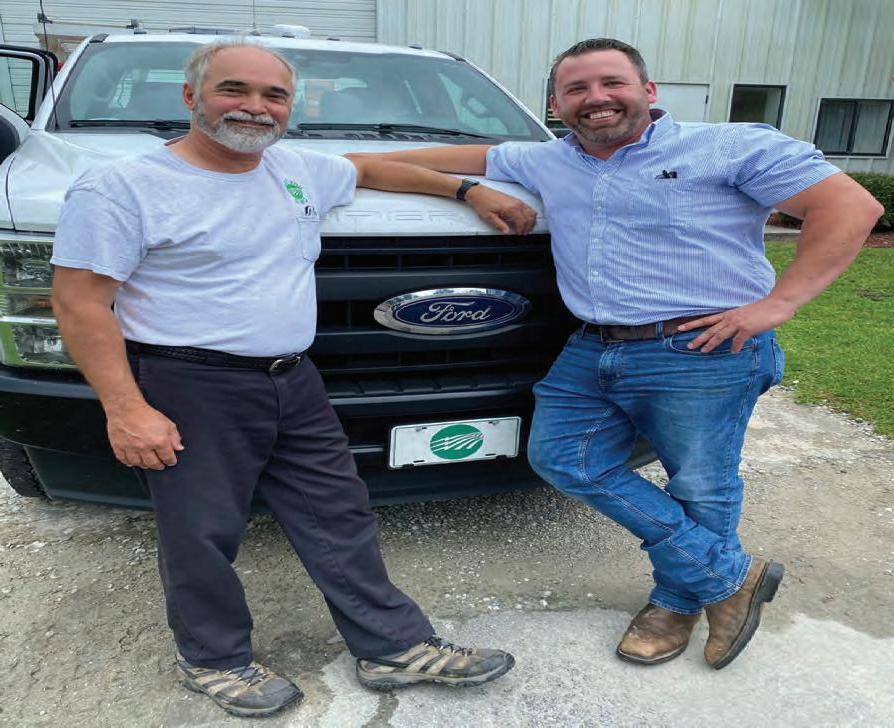
Passing the baton
In early 2020, lineman Josh Bain stepped away from his career at Tideland to help wife, Hope, with the expansion of her rapidly growing nutrition business. They also expanded their family with the birth of their second child, Brody. In the interim, Josh couldn’t quite get Tideland out of his system. Utility posts often showed up on his social media.
Several months after Josh’s departure, senior staking technician John Marsh advised the co-op that he would retire the following year. That provided a pathway for Josh to return to Tideland, putting his years of experience and system knowledge to good use as John’s replacement. This provided invaluable continuity to our engineering operations in the co-op’s largest and fastest growing district. Having made the transition from lineman to staking technician himself, John can attest to the advantage Josh has having performed the actual linework that stakers map out. During his tenure, John says the greatest workplace improvement has been the tagging and toning of underground facilities which have vastly improved safety and operational efficiencies. The co-op also undertook a massive mapping project that returned all assemblies to Rural Utilities Services standards which in turn streamlined inventory.
As a small utility, Tideland stakers wear many hats and are often the first co-op employee members engage with in person. We have no doubt that John has left this important job in good hands as he passes the baton to Josh.
www.tidelandemc.com
BOARD OF DIRECTORS
J. Douglas Brinson, President Clifton Paul, Vice President Mark Carawan, Secretary David Ipock, Treasurer Rudy Austin, Garry Jordan, Dawson Pugh, Paul Sasnett, Wayne Sawyer & Charles Slade
GENERAL MANAGER & CEO
Paul Spruill
EDITOR
Heidi Jernigan Smith
Member Service
252.943.3046 800.637.1079
24 Hour Outage Reporting & Automated Services
252.944.2400 800.882.1001
Tideland EMC is an equal opportunity provider & employer
Facebook “f” Logo CMYK / .eps Facebook “f” Logo CMYK / .eps


Prepare Now, Update Your Plan

Stay safe and healthy during a disaster
By Derrill Holly

Families always need to be prepared for emergencies, and ongoing concerns triggered by the COVID-19 pandemic have prompted several new recommendations for evacuation planning, emergency supply kits and community shelter operations.
“We did a lot of work in 2020 to update our guidance for hurricanes, wildfires and other natural disasters to include COVID-19 guidance,” says Capt. Renée Funk of the Centers for Disease Control and Prevention (CDC).
“We recommended a hand sanitizer that’s at least 60% alcohol, disinfectant wipes and two masks for each person,” Funk says. “Those things should be considered permanently added to your go kit, and you need to regularly check for expiration dates for these products.”
Fresh approaches to community shelters implemented and refined in 2020 are also expected to remain in place indefinitely. Instead of large, centralized shelters in schools or other community buildings, the CDC, the Federal
Emergency Management Agency (FEMA) and their state IN POWER. SINCE 1920. and community partners have turned to dispersed sheltering, which is more conducive to social distancing. Remember, in the event of any emergency or natural disaster, you’ll want to be prepared to shelter in place for several days if necessary. FEMA recommends having an R&T Power Systems delivering emergency kit stocked with all important supplies in the promise to always keep you one or two containers that are easy to access. out of the dark! #PromiseOfPower RTPowerSystems.com

Visit ready.gov/kit for a full checklist of disaster kit items and additional recommendations.
SERVING EASTERN NC
Derrill Holly writes on consumer and cooperative affairs for the National Rural Electric Cooperative Association, the national trade association representing more than 900 local electric cooperatives. 252-773-0739
Love Carolina Country? Don’t miss an issue!
Subscribe and get Carolina Country in your mailbox every month for just $1 an issue!
Co-op Members, check with your electric cooperative to find out if they offer complimentary subscriptions as a benefit of membership.
Yes! Please start my subscription.
NAME

MAILING ADDRESS
CITY STATE ZIP
PHONE NUMBER (If we have questions) EMAIL
1 Year (12 issues) $12 2 Years (24 issues) $24 Check Enclosed
Make checks payable to: “Carolina Country.” Mail to: Carolina Country Subscriptions, 3400 Sumner Blvd., Raleigh, NC 27616 Or subscribe online at carolinacountry.com/subscribe



